Contributed By
Published
Something went awry in the plans of the Towers' builders. Robert Frazer suggests that the Panzer world has become another battlefield where the ghosts of the Ancients still continue to clash.
Contents
- Introduction
- Quis custodiet ipsos custodes?
- Inter alia
- O tempora! O mores!
- Quid Pro Quo?
- POSTSCRIPT: Naught but a Weapon
Introduction
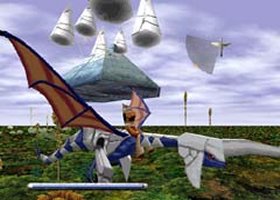
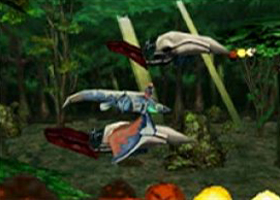
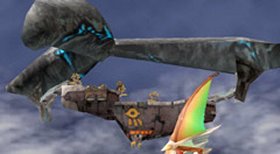
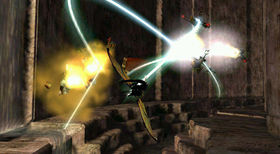
In their various treks across the blasted continent on which Panzer Dragoon is set, Lagi, the Blue Dragon (if you agree with Lance Way’s theory of the Eins mount being a separate creature), and their various riders have had to contend with all manner of adversaries in their missions. They have routinely massacred human enemies blinkered and presumptuous enough to have pretensions of matching the might of the Ancient Age’s deadliest dragon(s) - the Meccania Federation, the Empire, and Craymen’s renegade Black Fleet have been but the metaphorical stubble to their swords (Oliver Cromwell may be one of the most infuriating men in history, but he’s just so damned quotable!).
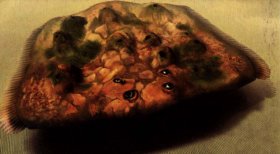
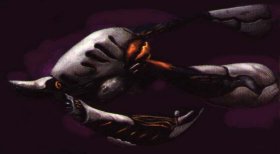
Yet the human factions and their revived relic-weapons are not the only threats that present themselves to the player during the course of the games. Indeed, the first enemies that you are called upon to battle in each of the Saturn-based instalments of Panzer Dragoon are none other than the more active descendants of the era lost ten millennia ago - the Bio-Engineered creatures. These are divided into two categories - unearthly pure-type monsters, and the more naturalistic mutant breeds that have dispersed throughout the world and since been incorporated into the general ecology.
The identity of the pure-types has long been confirmed - they are and were the direct creations, tools, and ultimately apocalyptic weapons of the Ancients. With their masters long dead or fled from the planet they are now invariably stationed as implacable, imperturbable sentinels of the Towers and the other facilities that survived the fall from grace. Orta’s encyclopaedia section explicitly confirms they are:
living testaments to the awesome destructive powers of the technology of the Ancient Age
Yet how do we define the pure-types’ estranged relatives, the mutants? Many Panzer Dragoon commentators have been quite satisfied to accept the vox populi that the mutants, as implied by their name, are degenerate pure-types - failed monsters that the vagaries of biology degraded from the elevated stature of the Ancients’ guardians to plebeian animals, weak and belaboured by the need to nourish themselves, propagate, and respond to the environment like any other fauna.
In this article I am going to demolish the comfortable consensus stated above, for my recent investigations into the nature of the Panzer realm have caused me to realise that this simplistic assumption is untenable. I have come to conclude that far from being assorted Darwinian freaks and flukes, there is a much more macabre and sinister reason that motivated the emergence of the mutants in the modern world.
Quis custodiet ipsos custodes?
Who will guard the guards? It is a particularly apposite question, for addressing it exposes the flawed nature of the current consensus on the origins of the mutants (that is, development through spontaneous mutation, natural selection, et al). It is a necessary inquiry, too, because I must of course debunk the old hypothesis before I can introduce its replacement.
It is important to be very clear and precise about the nature of pure-types. Whilst possessing fleshy forms, they are emphatically not animals. Indeed, they should be more likened to machines than monsters, and complaining that bodies of bone and muscle are distinct from those of steel and pistons is little more than petty semantics. No natural creature could ever feasibly endure with the body of a pure-type:
They have very inorganic looking features, and often do not have biological external organs, such as eyes, mouths, etc.
Also, these convoluted forms are augmented with all manner of unnatural and biologically impossible weaponry:
…gravitational control, optical flares and lasers, shock waves generated by supersonic sounds…
Furthermore, it can be inferred from the pure-types’ cold, unemotional form of combat - no squawks of pain or rage, simply relentless, silent efficiency - that they are far from possessing even most basic of primal instincts we accord to animals. Pure-types tender to no senses of pain, fear, desire or weariness. If they think, then it is only in rigid mathematical terms of tactics. They are motivated by only one impulse, one drive - their cruelly straightforward and uncompromising program.
…they were created as autonomous sentries of sorts, whose sole purpose was to defend the ancient ruins, before they became ruins.
If a human approaches, these creatures will spring to life and will not cease until destroyed, or their targets are destroyed.
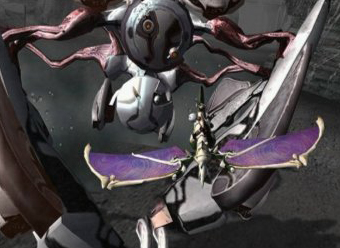
Stern, permanent, singular, inexorable - the pure-types have all the hallmarks of an engine, even if it is organic. Testaments to the mechanical function of the pure-types can be found in places like the Forbidden Zone (Disc One, Saga) and the Sea of Ash/Epicentre (Episode III, Orta). The territories that these pure-types were supposed to defend have long since vanished - sunken into the continent’s inland sea or smothered underneath the lifeless dunes - yet the pure-types remain, in massive numbers (indeed, you have to weave a hazardous course through the fire of an entire cloud of ‘Seba’ pure-types on first entering the Sea of Ash), still eternally warding away all intruders even though any reason for this crumbled away millennia ago. The pure-types know nothing else because they are nothing else - a weapon.
If the artificial aspect of the pure-types required any more exposition, then we should recognise that constituents of this higher tier in the bio-engineered panoply are not conceived by mating, and incubated in and gestated from females - they are manufactured or synthesised:
Though with slight variations, Towers’ responsibilities can be divided into two categories: Preservation/Regeneration, and Production/Analysis of the monsters.
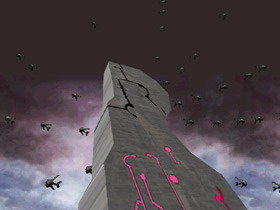
So - who will guard the guards? We must recognise that the condition of the pure-types is intensely regulated by both the Towers that build the monsters and the monsters themselves. Considering that the Towers existed to rejuvenate the world, it is only natural to assume that they also maintain the constructs designed to police this new Eden - an activity which is implied by the “analysis of the monsters”. Furthermore, the pure-types themselves are comprehensive in erasing any threat to the facilities they defend and the halcyon paradise such installations are erecting - they don’t discriminate in the creatures they destroy. Mutant creatures are perceived as aberrations to be terminated with as much impunity as that meted out to the unfortunate, abused humans - a fact made emphatically clear to Kyle when the remnants of the Goraia he was pursuing, completely savaged, flopped to the ground beside him into the intro to Eins.
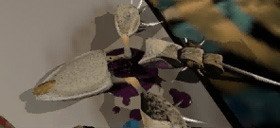
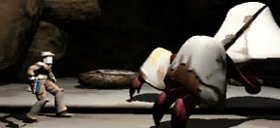
This gruesome and unsettling image is an essential one. With such a rigorous system enforced, mutants simply shouldn’t exist! Pure-types are constantly monitored by their ‘paternal’ Tower, and even without a Tower’s impulse pure-types will immediately fall upon and rend asunder any defective model amongst their ranks - the Orta encyclopaedia reports this transpiring to “Carrier” Seba which demonstrate incipient symptoms of corruption. As such, we can see that any mutant strain is identified, isolated, and expunged from the pure-type dominion before it can pose a threat to the Will of the Ancients that hangs over every Panzer Dragoon game like a pall. This de facto ‘immune system’ should ensure that mutants don’t exist - then why on God’s green earth do they?
Compiler Zadoc (a Seeker from Saga) suggested a reason. He noted “The Towers have worn down. They are not functioning efficiently” in one of his reports, simply implying that their review mechanisms had developed holes through which mutants could slip. Yet this does not account for Ancients’ fail-safe system and planetary Tower co-ordinator - Sestren - and I shall explain later how the scenario Zadoc describes seems suspicious. No, we must admit that our current paradigm of understanding about the mutants’ origins does not satisfactorily explain the questions I have raised.
This is nothing short of an absolute crisis in the background to Panzer Dragoon, for it shows that the assumption that the mutants were spawned from ‘de-evolved’ pure-types through the processes of nature - cruel and arbitrary, but innocent of any ulterior machinations - was one taken in bad faith, mala fide. Randomness could not hope to infect the watertight system devised by the Ancients… so we can only conclude that intelligence did.
Inter alia
Most of our lives are governed, if not by laws, then by immanent conventions - mannerisms and sensibilities that are not enforced by a body of authority but which we nonetheless, and often unconsciously, defer to - a racial psyche, if you will. We commonly call such a concept ‘decency’ and ‘civility’, and it pervades our societies, be it in the “that’s not cricket!” of abused fairness in private quarrels or the more portentous matters of the national constitution in utterances like “no legislation should prevent the Prime Minister from dining with the Opposition.”. It is this indispensable, pervasive conditioning that prevents the world of man from imploding into the “nasty, brutish, and short” horror raised in Hobbes’ Leviathan.
Yet as enthusiasts of Panzer Dragoon know all too well, the traumatic and cataclysmic end to the Ancient Age fulfilled that quote to the very letter. Any scenario where humanity was willing to drive itself to teeter on the precipice above the abyss of extinction was quite obviously one where the above atmosphere had been all but completely scoured away. So it was that when the Ancients finally restored a measure of sanity to themselves and engaged in their plan to replenish the world that they (for whatever reason) had ravaged, there was a inconsolable band who were determined to wreck and smash even this desperately vital project - the Rebels.
Little is known about the faceless Rebels. We are unaware if they were the inhabitants of a country defeated by a victorious power (a Pyrrhic victory, certainly, given the circumstances) in the Ancient Age that agitated for the Towers, or a disparate and irregular agglomeration of malcontents from across the Ancient spectrum. The only element we are certain about is that they were violently opposed to the creation of the Tower network - what little else can be elucidated about them can be found in Solo Wing’s short article.
The Rebels apparently had considerable active force to make their objections stridently heard - the Towers were instructed to construct their own pure-types to defend against Rebel incursions, and Rebels were able to thieve Azel from the Ancients’ Uru laboratories. Considering their subterranean and sprawling nature, the fact that the Ancients would most likely zealously defend them (the dragons were also developed at Uru, so it was evidently an important institution), and the prominent nature of the commodity they were attempting to capture, the Rebels would have required nothing less than a full-scale all-arms military assault to have achieved it.
As already discussed, there must be some purposeful organised origin behind the emergence of the mutants. I could suggest that they were intended as part of the Ancients’ plan, with pure-types deliberately engineered to be gradually ‘self-decommissioning’ and integrated into the natural ecology as the world became restored and they became superfluous. However, whilst elegant and suggesting that the Ancients were motivated by at least some degree of altruism, this hypothesis doesn’t stand up to scrutiny. The world has been plagued with mutants for millennia, long before the world was in a fit state to harbour life in large quantities. Also, if they mutants were considered benign by the Ancients, the pure-types shouldn’t attack them so readily - and Abadd, a drone of the Ancients, referred to them contemptuously as “simple creatures” after killing the els-enora family at the conclusion to Episode V in Orta - this doesn’t seem to convey much respect for an element of Ancient ambition.
So, we can judge that the figures responsible for the contamination of the Will of the Ancients are the only other faction we know of - the Rebels. How else would a plainly malignant and malevolent infection debilitate the pure-types, and the Towers which the Ancients had exactingly and painstakingly designed to be the eternal custodians of the world ever be fatigued in the way Zadoc suggests?
O tempora! O mores!
I cannot say for certain exactly how the Rebels achieved this final blow against their foe, the Ancients, but it is something we must accept ipso facto as it is the only consistent explanation. At the close of the Ancient Age, the remnants of the Rebels were thwarted in their bid to prevent the emergence of the Tower network by the Ancients (this failure is seen in that the Towers exist today). Yet instead of acquiescing to the fait accompli of their defeat - regardless of whether their cause was just or not - in one obstinate, defiant, venomous and bitter last gasp, the Rebels managed to successfully introduce a virus throughout the Towers. Although it would require time to incubate, infiltrate and disseminate across each Tower, this contagion would proliferate like a despicable cancer, poisoning every facet of the pure-types it aggressively invaded - and, in the ultimate humiliation to the Ancients, debasing their most precious creation into an animalistic mockery of their clean sophistication.
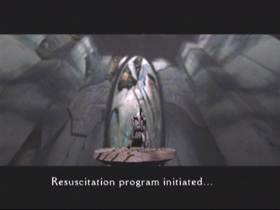
And thus we are belaboured with the appalling scenario of the War Without End that forms this theory’s title. Some humans remained on the surface after the close of the Ancient Age - these people chose or were compelled to do so instead of uploading their consciousnesses into Sestren-space (like how the Divine Visitor could have done), retreating into subterranean stasis shelters (such as Abadd’s masters in Orta), or maybe even fleeing the planet altogether. As such, they have been subjected to ten thousand years of harsh oppression, enforced penury and living on the scarcest subsistence level - yet not only through the adversity of an inimical climate thrown out of balance by the Ancients’ wars, but through the deprecations of pure-types and mutants alike. Even after ten thousand years of effective extinction, the war between the Ancients and the Rebels is still being fought - modern humanity is being tossed about between the clashes and beating passions of the pure-types and the mutants, as the former struggles to achieve dominion over a purified world and the latter erupts out in a bid to tear their edifices down.
It’s a truly disarming tragedy to see the world represented in this light, a testament to how hostile the Panzer world truly is - tarnished, blemished and barren, the dusty arena where the gladiators of past hopes and prejudices alike still continue to gore each other and spill the precious ichors of the opposing belligerent - and do so purposelessly, long after all the spectators of this titanic duel departed.
Quid Pro Quo?
But seeing as how the Rebels lost their war against the Ancients and, so far as we know with what limited evidence we possess, didn’t survive the end of the Ancient Age, why would they pervert the Towers? What did they hope to achieve if they wouldn’t be there to witness their plot’s fruition?
Spite.
It may sound petty, but that doesn’t detract from its viability. Twisted, knotted and contorted with seething hatred and black loathing of the Ancients, and embittered by burning shame and choking humiliation of their defeat, the surviving Rebels had a tantrum. If they were to be banished to hell, they would ensure that the Ancients’ toys would be dragged into perdition with them. Ruining the Will of the Ancients was a nefarious act - nothing but revenge in its very basest form. The Rebels were revelling in insular narcissism - what concern was the future of the world and life itself to them, as long as they had one last chance to spit in the eye of their enemy?
There is an alternative explanation, suggestions of which can be ferreted out of a single reference in the Orta bestiary. In the entry describing the yondo-worm (the giant mutant that Mobo and the other wormriders were hunting in Episode II), it is observed:
Researchers have discovered that these creatures actually have organs that allow them to digest and absorb mercury from the polluted waters. Some scientists even claim that these creatures are like giant living filters and that any body of water that a Yondo-Worm has lived in for long periods of time eventually becomes drinkable again.
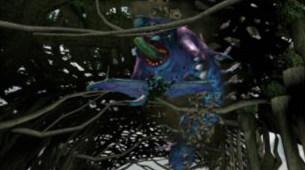
This presents an interesting slant on the quarrel between the Ancients and the Rebels. It is fair to concede that the Rebels were most likely not suicidal - they would probably wish the world to be restored as much as anyone - and the casus belli for the war over the Towers was not the fundamental question of whether the world should be repaired, but the instrumental question of how it was to be achieved. The Ancients’ Towers provided a viable solution, but one which the Rebels saw as unfair - it placed the Towers and their creators as imposing overlords over the world and the sole fount of survival, ensuring that the Ancients would remain at the pinnacle of civilisation and power when they returned to reclaim the world. This reinforces the notion that the Rebels were nations and groups defeated in the earlier wars whose assorted fallout necessitated the creation of the Towers, and the Ancients were the collective people and organisations that were the victors, if the former took this view of the latter).
The Rebels were proposing a different scheme, one where the elements for planetary renovation were dispersed throughout the world in the blood of its very inhabitants - as seen in how the yondo-worm seems to purify the water it occupies. This would ensure that no one group could claim to have contributed more to rebuilding the world, so that there is no reason for divisions that would possibly lead to another round of wars reappearing. When they couldn’t destroy the opposing Ancient doctrine by preventing the construction of the Towers, the Rebels chose to achieve their model by converting the pure-types to the scheme they desired, and successfully infected the network with the perversion viruses.
It is a consistent and persuasive argument, and one which forms a logical and reasoned foundation for the history of the terrible collapse of the Ancient Age. However, I hesitate to accept it for a number of reasons. One is that I’m a Tory and so I won’t have all this egalitarian bunkum in my favourite games, damnit! :P But speaking seriously, there isn’t enough evidence to confirm it. We only have one instance of ‘beneficial’ mutants in the yondo-worm, and its apparently cleansing presence can be explained without any reference to ulterior Rebel motives - I don’t doubt that yondo-worms are not exactly fond of poisons either, or even use them as a food source, so its neutralising secretions could have evolved quite naturally and innocent of any pre-programming. A third criticism is an issue of psychology - if the men of the Ancient Age had driven each other to the brink of extinction, had their hatreds become so ingrained and absolute that they had lost even the most slender grasp on objectivity? That the Rebels saw fit to start a final war over the Towers, despite living in a time where straits were so dire you’d expect rational people to abandon political point-scoring and throw their energies into what seemed to be the most practicable method for repairing the world - whatever the method was (in this case, the Towers) - is highly suggestive of the possibility that the Rebels were a few sealances short of a Shelcoof, to say the least.
In conclusion, then, the War Without End enables us to realise that the story of Panzer Dragoon is one writ on a truly epic scale, spanning thousands of years and incorporating, strife, faith, politics and philosophy all in equal measure. And, more disturbingly, it forces us to realise the sombre and depressed tones that such an anguished and pained dystopia is coloured with.
POSTSCRIPT: Naught but a Weapon
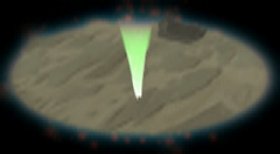
The machinations of the Rebels have another ramification on the modern Panzer world that is depicted in the games. Considering the ubiquitous nature of the Towers (the maps we have indicate at least fourteen facilities [I haven’t miscounted - the one shown does not include the Eins Tower], and this is just an incomplete section of but one landmass - there could be more than a hundred Towers throughout the entire planet.), it would understandably be an arduous task for the Rebels to successfully vandalise each one and simultaneously prevent the Ancients from repairing the damage.
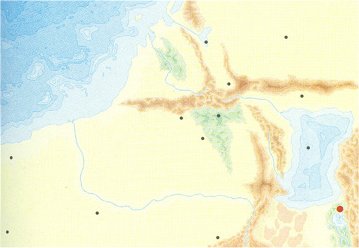
One possible explanation is that the Rebels didn’t contaminate every Tower, just enough to ensure that the mutants would be tolerably widespread for them to have an obvious effect. Another plan, however - and a decidedly more efficient one - was that the Rebels did not take the proverbial screwdriver to the machinery inside each Tower, but instead corrupted the programming of Sestren. Being the universal ‘master computer’ and information hub that unified and controlled all of the Towers, introducing disguised subroutines and algorithms into its schematics would ensure that instructions to create flawed pure-types with “trigger genes” (as noted in the ‘carrier’ Seba) primed to cause mutations were sent to each and every Tower without Sestren even realising that it had been meddled with. It’s also possible that the agents which caused Sestren to be destabilised are still skulking about and lingering in Sestren-space, knocking into elements of and disturbing the precise order of this fantastic extra-dimensional realm of the Ancients.
One such element of this realm was what has become known as the ‘Heresy Program’, which some see as a sentient sentinel-program that policed Sestren-space like how pure-types guard the Towers - anti-virus software, if you will. Eventually, this program decided the Will of the Ancients was unnecessarily repressive and sought to defect from Sestren, whereupon it was expelled from Sestren-space and sought refuge in the body of a coolia/khourieat to evolve into Lagi, the dragon played in the games. Yet why did the Heresy Program find it necessary to wait until 71 A.F. to suffer its crisis of confidence? Surely even the stodgiest of synapses in the most hopeless of dunces doesn’t require ten thousand years to mull over an issue of morality! There must have been an impulse that drove the Heresy Program to become a turncoat. Furthermore, Sestren identifies the Heresy Program as an impurity…
Was the Heresy Program actually a faithful servant of the Will of the Ancients all along, but inadvertently infected by a remaining Rebel virus? Is Lagi, contrary the image of him as a defender of independence and freedom, nothing more than a tool of another power…?
